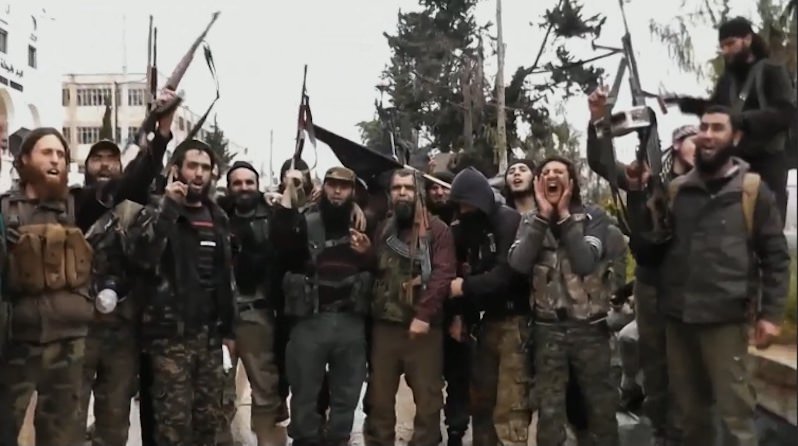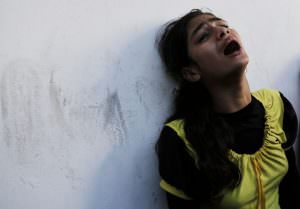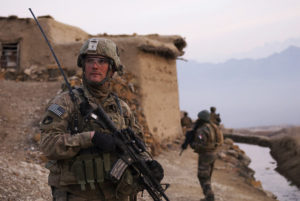Syria’s ‘Hell on Earth,’ Up Close and Personal
Footage of real-life bloodshed justifies the infernal title of Sebastian Junger's documentary film, co-directed by Nick Quested. Still image from Sebastian Junger and Nick Quested's documentary "Hell on Earth: The Fall of Syria and the Rise of Isis." (National Geographic)
Still image from Sebastian Junger and Nick Quested's documentary "Hell on Earth: The Fall of Syria and the Rise of Isis." (National Geographic)
Still image from Sebastian Junger and Nick Quested’s documentary “Hell on Earth: The Fall of Syria and the Rise of Isis.” (National Geographic)
It was only a matter of time before journalist Sebastian Junger became a filmmaker. Prior to working as a contributing editor at Vanity Fair, his breakthrough book “The Perfect Storm,” a real-life disaster drama shored up by Junger’s solid storytelling, was turned into a cheesy movie starring George Clooney. With numerous interviews and visits to Gloucester, Mass., home to the crew of the ill-fated fishing boat, the Andrea Gail, there was no need to sail into the eye of a hurricane to get the story.
Junger’s approach changed with his 2010 Oscar-nominated documentary, “Restrepo,” in which he embedded himself with a platoon of roughly two dozen U.S. soldiers on a volatile ridge in Afghanistan’s Korangal Valley. Unnerving proximity to firefights familiarizes viewers with real-life soldiers, heightening the visceral impact when they are struck down by enemy bullets.
With his latest film, “Hell on Earth: The Fall of Syria and the Rise of Isis” — which had a limited theatrical run and premiered earlier this month on the National Geographic Channel — Junger and co-director Nick Quested kept clear of the firing line, opting instead to put cameras in the hands of activists, journalists and everyday Syrians to get a glimpse of life in the midst of the world’s most brutal conflict.
Watch the documentary’s trailer here. For a longer look at the film, click here.
Not just violence, but real-life horror warrants the movie’s infernal title. Early in the film, a teenage Syrian boy is punished by government torturers for taking part in scrawling anti-government graffiti on a wall, prompting protests seen in smartphone footage as unarmed Syrians are gunned down in the streets. The terror escalates in Islamic State propaganda clips in which civilians are beheaded while horrified townspeople look on. The victims’ bodies are suspended upside down for all to see, a warning to those who would defy the occupiers.
Most unnerving in “Hell on Earth” is footage shot in 2012 by French terrorist Mohammed Merah, who killed seven people in three attacks. The first-person shooter POV shows him on his motorcycle at a stoplight where he meets another biker, an off-duty soldier from the local barracks. They pull into an empty parking lot, ostensibly to chat, when Merah points a gun at him and orders him to the ground. The soldier’s refusal is met with blast as the screen cuts to black.
On a more poignant note, a Syrian civilian named Marwan Mohammed appears in several scenes, holed up somewhere near Aleppo with his wife and small children, as well as his brother Radwan and his family, while bomb blasts echo nearby. “I smile against my will so the kids don’t get scared,” he says as the two families plan a secret escape from their war-torn homeland.
Junger and Quested organize the multisourced material in a straightforward chronology, tracing a complicated conflict with roots in the Arab Spring. Syrian President Bashar Assad clearly took note of the 2010 pan-Muslim movement that toppled dictators like Hosni Mubarak in Egypt and Moammar Gadhafi in Libya. Borrowing a page from his father, Hafez Assad, who killed an estimated 20,000 civilians in his brutal crackdown on the Muslim Brotherhood in the Syrian city of Hama in 1982, the younger Assad did likewise, attacking protesters with machine guns. That deadly act ignited demonstrations throughout the country, each met with gunfire. The president’s message is made clear by the writing on the wall, as graffiti shown in one scene spelled out: “It’s Assad, or we burn up the country.” When legions of his soldiers defected to fight alongside besieged civilians, the Free Syrian Army was formed.
As the tide began to turn against Assad, he passed an amnesty, freeing over a thousand jihadists from prison. According to Junger’s movie, it was this action, combined with Bush-era de-Baathification in Iraq, that contributed to the rise of Islamic State. While the difference between U.S. forces in Iraq and Islamic State in Syria may seem obvious to most, “Hell on Earth” offers the direct viewpoint of the occupied, many of whom draw little distinction between American GIs storming their living rooms and taking away their sons and jihadists who spill their blood in Allah’s name.
Such righteous bloodletting is not unprecedented, as illustrated by centuries-old etchings, of which Junger and Quested’s film takes note, of prisoners being drawn and quartered by the British government. More recently, during China’s Cultural Revolution, anti-communists were occasionally ripped to pieces by mobs and in some cases cannibalized. Even here in America’s Jim Crow South, townspeople happily posed for photos with the bodies of lynching victims.
President Obama’s famous “red-line” admonition comes under scrutiny in “Hell on Earth,” which notes that numerous Syrian army defectors were inspired by that promise and later abandoned. A brief mention is made of former British Prime Minister David Cameron’s government losing a 2013 vote for military action in Parliament, but the fact that Obama was confronted with congressional intransigence on the issue gets no mention in the film.
Ultimately, like so many refugees, the way out of the conflict for Marwan and his family was through Turkey. But for his country, the exit route is exponentially more complicated. Early on in “Hell on Earth,” we learn that militias formed rapidly because they attracted funding. Money interests in the war are multifaceted, whether concerning those that are visible, like Russia’s involvement on behalf of Assad, or those that are not, as with the purchasers of Islamic State’s oil and other sources of terrorist funding.
At the group’s peak in 2014, Islamic State controlled large swaths in the north of both Syria and Iraq, governing some 6 million people. Today, Islamic State members have mostly retreated to their last bastion, Raqqa, which earlier this month came under attack by the Syrian army. The organization is headed for collapse, but lone wolves will likely continue their reign of terror on a smaller scale.
As for the Syrian civil war, there appears to be no end in sight. With the blood of 470,000 people on his hands and 6.5 million displaced, Assad may find himself reigning over little more than a pile of rubble before peace is declared.
Your support matters…Independent journalism is under threat and overshadowed by heavily funded mainstream media.
You can help level the playing field. Become a member.
Your tax-deductible contribution keeps us digging beneath the headlines to give you thought-provoking, investigative reporting and analysis that unearths what's really happening- without compromise.
Give today to support our courageous, independent journalists.






You need to be a supporter to comment.
There are currently no responses to this article.
Be the first to respond.